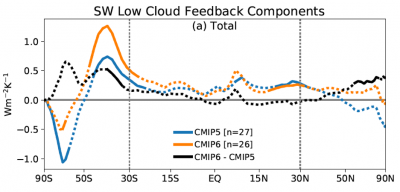Latest Earth System Models Predict More Global Warming than their Predecessors
Scientists at Lawrence Livermore National Laboratory in collaboration with colleagues from the University of Leeds and Imperial College London have found that the latest generation of earth system models simulates more warming in response to increasing carbon dioxide than their predecessors. The primary culprit for enhanced warming was shown to be clouds. Specifically, the water content and coverage of low-level clouds decrease more strongly with global warming in the latest models, causing enhanced planetary absorption of sunlight—amplifying feedback that ultimately results in more warming. Differences in the physical representation of clouds in models were shown to drive this enhanced sensitivity relative to the previous generation of models.
The severity of climate change is closely related to how much the earth warms in response to greenhouse gas increases. Here it was found that the temperature response to an abrupt quadrupling of atmospheric carbon dioxide has increased substantially in the latest generation of earth system models. Given that these latest models represent aspects of the climate system better than their predecessors, it will be crucial to establish whether they are also providing a more realistic picture of future climate warming.
Equilibrium climate sensitivity, the global surface temperature response to carbon dioxide doubling, has been uncertain for decades. Recent consensus places it likely between 1.5˚C and 4.5˚C. Global climate models (GCMs), which attempt to represent all relevant physical processes, provide the most direct means of estimating climate sensitivity via carbon dioxide quadrupling experiments. Here we show that the closely related effective climate sensitivity has increased substantially in Coupled Model Intercomparison Project phase 6 (CMIP6), with values spanning 1.8 - 5.6˚C across 27 GCMs and exceeding 4.5 degrees in 10 of them. This (statistically insignificant) increase is primarily due to stronger positive cloud feedbacks from decreasing extratropical low cloud coverage and albedo. Both of these are tied to the physical representation of clouds which in CMIP6 models lead to weaker responses of extratropical low cloud cover and water content to unforced variations in surface temperature. Establishing the plausibility of these higher sensitivity models is imperative given their implied societal ramifications.

